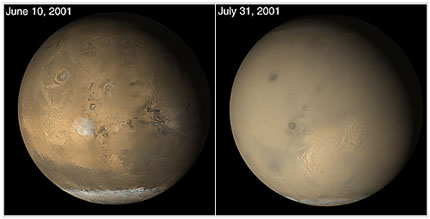Mars dust storms are much different than the dust devils that many people have seen in images sent back from the planet. On Mars a dust storm can develop in a matter of hours and envelope the entire planet within a few days. After developing, it can take weeks for a dust storm on Mars to completely expend itself. Scientists are still trying to determine why the storms become so large and last so long.
All Mars dust storms are powered by sunshine. Solar heating warms the Martian atmosphere and causes the air to move, lifting dust off the ground. The chance for storms is increased when there are great temperature variations like those seen at the equator during the Martian summer. Because the planet’s atmosphere is only about 1% as dense as Earth’s only the smallest dust grains hang in the air.
Surprisingly, many of the dust storms on the planet originate from one impact basin. Hellas Basin is the deepest impact crater in the Solar System. It was formed more than three billion years ago during the Late Bombardment Period when a very large asteroid hit the surface of Mars. The temperatures at the bottom of the crater can be 10 degrees warmer than on the surface and the crater is deeply filled with dust. The difference in temperature fuels wind action that picks up the dust, then storm emerge from the basin.
The dust storms were of great concern when probes were first sent to Mars. Early probes happened to arrive in orbit during large events. The Viking missions of 1976 easily withstood two big dust storms without being damaged. They were not the first missions to survive Martian dust storms. In 1971, Mariner 9 arrived at Mars during the biggest dust storm ever recorded. Mission controllers simply waited a few weeks for the storm to subside, then carried on with the mission. The biggest issue that rovers face during a dust storm is the lack of sunlight. Without the light, the rovers have trouble generating enough power to keep their electronic warm enough to function.
Mars dust storms are of great interest to scientists. Even though several spacecraft have observed the storms first hand, scientists are no closer to a definitive answer. For now, the storms on Mars are going to continue to present challenges to planning a human mission to the planet.
Here’s an article describing how the dust storms threatened the Mars rovers, and another discussing how electrical dust storms could make life on Mars impossible.
Here’s one of the best articles from NASA about the dust storms, and another gallery from NASA/JPL.
Finally, if you’d like to learn more about Mars in general, we have done several podcast episodes about the Red Planet at Astronomy Cast. Episode 52: Mars, and Episode 91: The Search for Water on Mars.
Sources:
http://science.nasa.gov/science-news/science-at-nasa/2003/09jul_marsdust/
http://www.jpl.nasa.gov/news/news.cfm?release=2007-080
http://science.nasa.gov/science-news/science-at-nasa/2001/ast16jul_1/

